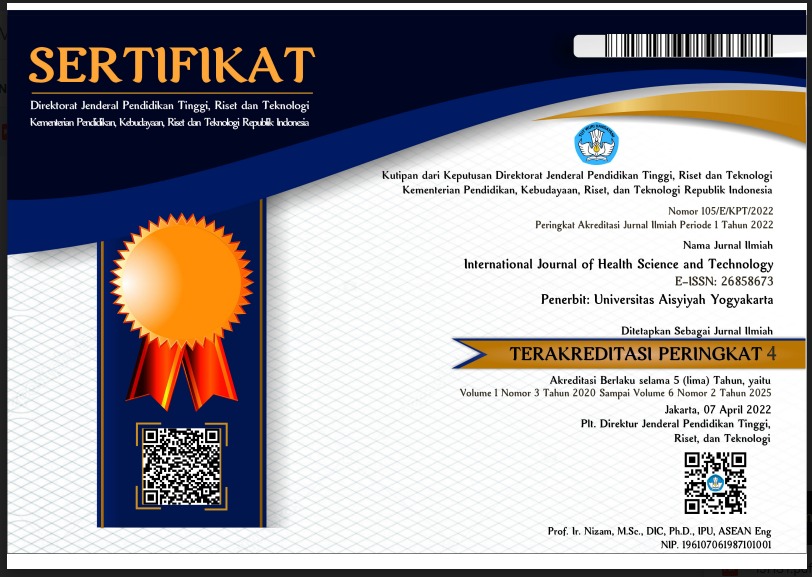The effect of prayer beads therapy on lowering blood pressure in hypertensive patients
DOI:
https://doi.org/10.31101/ijhst.v5i3.3406Keywords:
blood pressure; hypertension; prayer beads therapyAbstract
Downloads
References
Agustin, F. , H. H. , S. F. (2024). Pengaruh Terapi Dzikir terhadap Tekanan Darah dan Kualitas Hidup pada Lansia Hipertensi. Jurnal Penelitian Perawat Profesional, 6 (1), 411-418.
American Heart Association (AHA). (2016). Ejection Fraction Heart Failure Measurement. http://www.heart.org/HEARTORG/Conditions/HeartFailure/SymptomsDiagnosisofHeart Failure/Ejekction-FractionHeartFailureMeasurementUCM.
Andri, J., Permata, F., Padila, P., Sartika, A., & Andrianto, M. B. (2021). Penurunan Tekanan Darah pada Pasien Hipertensi Menggunakan Intervensi Slow Deep Breathing Exercise. Jurnal Keperawatan Silampari, 5(1), 255-262.
Arifin, R., Alkaf, I., & Indrayani, H. (2022). Dampak Zikir Khafi terhadap Ketenangan Jiwa pada Pengamal Tarekat Qadiriyah Naqsabandiyah. Jurnal Tasawuf dan Psikoterapi, 3(2), 98–117. https://doi.org/https://doi.org/10.19109/sh.v3i1.13148.
Aprillya M.T. (2016). ‘Hubungan Antara Umur, Aktivitas Fisik dan Stress Dengan Kejadian Hipertensi
di Puskesmas Kawangkoan’, Jurnal Fakultas Kesehatan Masyarakat Universitas Sam Ratulangi,
(3).
Apriyati, N. (2022). Pengaruh Pemberian Terapi Asmaul Husna terhadap Tingkat Kecemasan Pasien Pre Operasi Spinal Anestesi di RS PKU Muhammadiyah Yogyakarta. Anaesthesia Nursing Journal, 1(1), 78–85. https://doi.org/10.29238/anj.v1i1.1165.
Arif Sumantri. (2017). Metodologi Penelitian Kesehatan (Vol. 1). Jakarta: Kencana Perdana Grup.
Basyier, A. Umar. (2013). Kedokteran Nabi Antara Realitas dan Kebohongan.Surabaya: Shafa Publik.
Chusna, n. C. (2015). Pengaruh intensitas membaca al-qur’an berdzikir dan menjaga wudhu terhadap pengendalian emosi santri di pondok pesantrentarbiyatul islam (ppti) al-falah salatiga tahun 2015 (doctoral dissertation, iain salatiga).
Fadhila, K. N. (2021). Hubungan Beban Kerja dengan Kejadian Hipertensi di Pasar Umum Purwodadi Kabupeten Grobongan Jawa Tengah. TSCD3Kep Journal, 6(1), 28–41. http://ejournal.annurpurwodadi.ac.id/index.php/TSCD3Kep/issue/archive.
Imaroh, I. et al,. (2017). Faktor Risiko yang Mempengaruhi Kejadian Hipertensi pada Ibu Hamil di Wilayah Kerja Puskesmas Kedungmundu, Kota Semarang Tahun 2017. Jurnal Kesehatan Masyarakat (JKM- e journal), Vol. 6 No. 1 Kementerian Kesehatan Republik Indonesia. (2018).
Laporan Nasional Riset Kesehatan Dasar. Kementerian Kesehatan RI, 1–582.
LeMone, Priscilla. , B. Karen. M. ,. (2016). Buku Ajar Keperawatan Medikal Bedah. Jakarta: EGC.
Lestanti, S. I. , & R. (2023). Penerapan Terapi Dzikir Asmaul Husna untuk Menurunkan Tekanan Darah pada Keluarga dengan Hipertensi di Desa Balutan Kecamatan Comal. Proceeding of the 16th
University Research Colloquium 2022: Mahasiswa (Student Paper Presentation), 811–814. http://repository.urecol.org/index.php/proceeding/article/view/2385.
Mills, K. T. , S. A. , H. J. (2019). 'The global epidemiology of hypertension’, Nature Reviews Nephrology, 16(4), pp. 223–237. Available at: https://doi.org/10.1038/s41581-019-0244-2.
Nugroho, S. T. , P. D. , & A. R. P. (2023). Aplikasi Terapi Dzikir untuk Menurunkan Kecemasan pada Pasien Hipertensi di Ruang Penyakit Dalam RSUD Kardinah Kota Tegal. Jurnal Manajemen Asuhan Keperawatan, 7(1), 40–44. https://doi.org/10.33655/mak.v7i1.154.
Nuraini B. (2019). Risk Factors of Hypertension. J Majority. Februari 2015;4(5): 10-18.
Nursalam, & Efendi, F. (2008). Pendidikan Dalam Keperawatan Nursalam Ferry Efendi. Jakarta: salemba medika
Purnika, R. , R. B. (2019). Pengaruh Meditasi Dzikir Terhadap Perubahan Tekanan Darah Pada Pasien Hipertensi. Jurnal Ilmiah Kesehatan Diagnosis, 14(4), 338-342.
Riskesdas. (2018). Badan Penelitian dan Pengembangan Kesehatan Kementerian RI tahun 2018. http://www.depkes.go.id/resources/download/infoterkini/materi_rakorpop_2018/Hasil%20Riskesdas%202018.pdf – Diakses Agustus 2018.
Sugiarti. (2021). Scoping Review: Hubungan Stres Kerja dengan Hipertensi pada Tenaga Kesehatan. Jurnal Integrasi Kesehatan & Sains, 3(1), 41–47. https://doi.org/10.29313/jiks.v3i1.7319
Downloads
Published
How to Cite
Issue
Section
Citation Check
License
Copyright (c) 2024 Tabihul Anwar, Cecep Eli Kosasih, Iqbal Pramukti, Dewi Yulianti Bisri

This work is licensed under a Creative Commons Attribution-ShareAlike 4.0 International License.
International Journal of Health Science and Technology allows readers to read, download, copy, distribute, print, search, or link to its articles' full texts and allows readers to use them for any other lawful purpose. The journal allows the author(s) to hold the copyright without restrictions. Finally, the journal allows the author(s) to retain publishing rights without restrictions
- Authors are allowed to archive their submitted article in an open access repository
- Authors are allowed to archive the final published article in an open access repository with an acknowledgment of its initial publication in this journal

This work is licensed under a Creative Commons Attribution-ShareAlike 4.0 Generic License.













